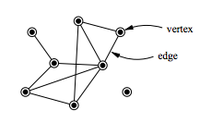
Photo from wikipedia
Seismic hazard evaluation before recent strong main shocks in the area of Greece is attempted using prior seismicity on the basis of earthquake network theory. The connections of earthquake networks… Click to show full abstract
Seismic hazard evaluation before recent strong main shocks in the area of Greece is attempted using prior seismicity on the basis of earthquake network theory. The connections of earthquake networks are constructed from successive earthquakes and the nodes are represented by cells of normal grids that were considered superimposed on the study areas. The dynamic evolution of the network structure is examined at sliding windows for identifying periods of statistically significant change, i.e., the network structure differentiation from that of a random network, where the structure is characterized by selected network measures, including the index of small-worldness property. By studying the structure of complex earthquake network, a distinct dynamic evolution is revealed, 2 months before the main shock occurrence. Particularly, the network measures, such as clustering coefficient and small-worldness index, tend to increase before and exhibit an abrupt jump at the time of the main shock occurrence, and then slowly decrease and become stable with small variations as before.
Journal Title: Acta Geophysica
Year Published: 2017
Link to full text (if available)
Share on Social Media: Sign Up to like & get
recommendations!